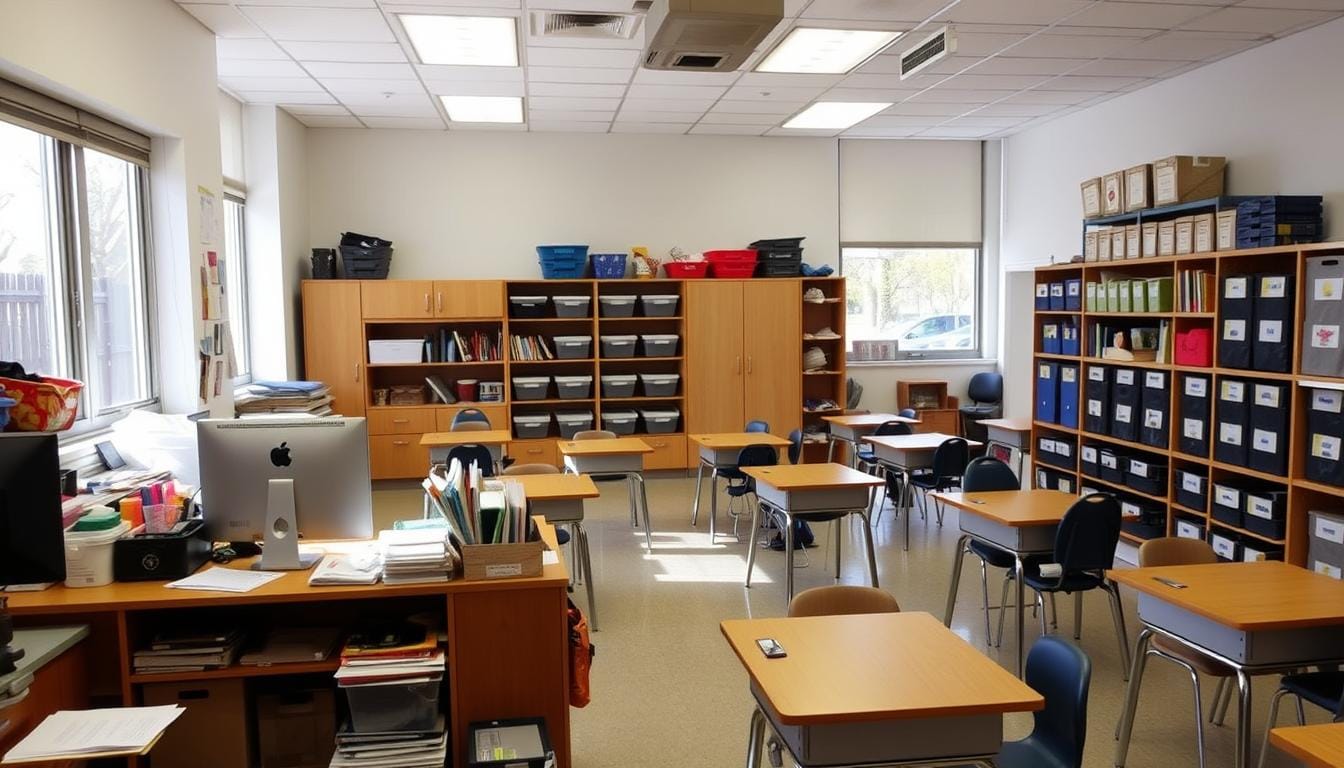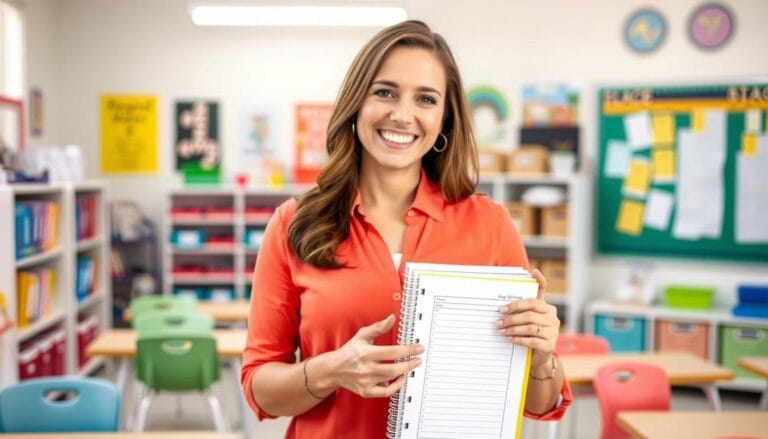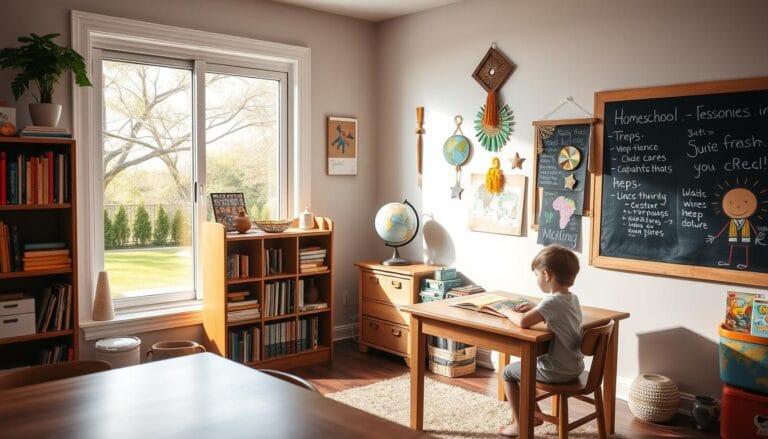Classroom Organization Ideas for a Tidy and Functional Learning Space
Every teacher remembers that magical moment when a well-organized classroom transforms learning. It turns from a challenge to an adventure. Creating an inviting classroom environment is more than looks. It’s about setting the stage for student success.
Table of Contents
Classroom organization is not just about arranging desks and shelves. It’s a strategic approach that can dramatically improve student engagement and learning outcomes. Research shows that 85% of teachers believe flexible seating enhances student focus. Organized layouts can reduce classroom distractions by up to 30%.
Your classroom setup directly impacts how students learn, interact, and grow. By implementing thoughtful organization strategies, you can create a space that not only looks neat. It also supports diverse learning needs and promotes active participation.
This guide will walk you through practical classroom organization techniques. You’ll learn how to design a dynamic, efficient learning environment. From maximizing space to creating functional learning zones, you’ll discover proven strategies to transform your classroom into a hub of creativity and productivity.
Get ready to unlock the potential of a well-organized classroom. Watch your students thrive in a space designed with intention and care.
Understanding the Impact of Classroom Organization
Classroom management is key to a good learning space. Studies show that organized classrooms change the way teachers and students learn.
Benefits of an Organized Learning Environment
An organized classroom brings many benefits. These advantages help students succeed:
- Increases student engagement by up to 25%
- Reduces disruptive behavior by 30%
- Improves student participation by 40%
- Enhances overall academic performance
How Organization Affects Student Performance
Good classroom management boosts student results. Structured learning environments can raise grades by 10-20%. An organized space helps students:
- Focus better on learning
- Stay less distracted
- Feel more confident and ready
- Learn to manage themselves better
Creating a Positive Classroom Atmosphere
A well-organized classroom is more than just a setup. It makes learning feel safe and predictable. More than 60% of teachers say a neat space helps them teach better.
With smart organization, you can make your classroom a lively place for learning. It will help students grow and do well in school.
Essential Elements of Classroom Layout Design
Creating a good classroom layout is key to a great learning space. It can affect how well students do, making up to 16% of their learning. The right seating can change how students interact and learn.
When setting up your classroom, think about these important points:
- Flexible spaces for different learning styles
- Clear paths for moving between work areas
- Specific spots for various learning activities
- Furniture that can be changed easily
There are many seating setups, each with its benefits. Let’s compare some:
| Seating Arrangement | Best For | Student Engagement |
|---|---|---|
| Traditional Rows | Direct Instruction | Low to Moderate |
| U-Shape | Group Discussions | High |
| Cluster Groups | Collaborative Learning | Very High |
| Semi-Circle | Interactive Learning | High |
Lighting, furniture, and room flexibility are also vital for a good learning space. By carefully designing your classroom, you can boost student engagement and meet different learning needs. This creates a lively and effective learning environment.
Maximizing Space in Small Classrooms
Small classrooms can be tough for teachers to set up for learning. But, with smart layouts and storage, you can make even tiny spaces great for learning.
Managing space well needs creativity and careful planning. The aim is to make a classroom that’s both flexible and useful for all kinds of learning. This way, every inch of space is used well.
Vertical Storage Solutions
When there’s little floor space, think up! Vertical storage is a smart choice for small classrooms. Here are some good ideas:
- Wall-mounted shelves for books and materials
- Hanging organizers for classroom supplies
- Magnetic boards for student work displays
- Stackable storage bins that use vertical space
Multi-functional Furniture Options
Pick furniture that does more than one thing to make your classroom better. Modular and flexible pieces can change your classroom:
| Furniture Type | Space-Saving Benefits |
|---|---|
| Storage Ottomans | Seating + hidden storage |
| Fold-away Tables | Easy reconfiguration of learning zones |
| Stackable Chairs | Quick storage when not in use |
Strategic Space Planning
Classroom organization is more than just picking furniture. Create distinct learning zones for different activities. Use mobile furniture to change spaces easily for different learning styles.
A well-organized classroom cuts down on distractions. It helps students focus better and makes learning more fun.
Classroom Organization Systems and Strategies
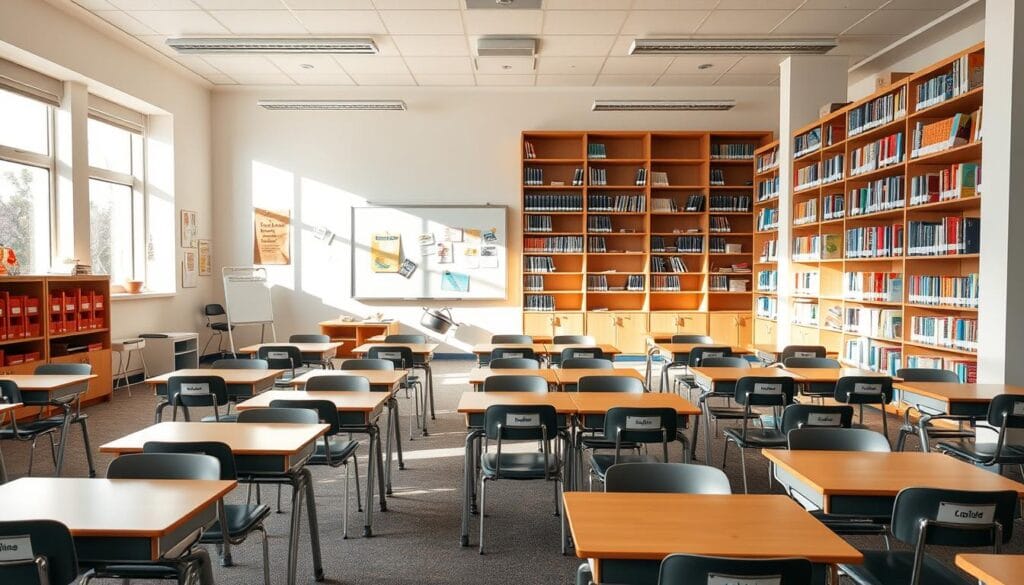
Creating a good classroom organization system makes learning spaces better. It turns chaotic places into places where students can focus. Studies show that good classroom management can cut distractions by 30% and boost student interest.
Organizing a classroom is more than just setting up the room. It’s about making a system that helps students and makes learning easier. Let’s look at some key strategies to improve your classroom.
Color-Coding Strategies
Color coding is a great way to organize a classroom. It can cut down the time it takes to find materials by 50%. Here are some ways to use color in your classroom:
- Use different colors for different subjects
- Make color-coded folders for student work
- Label materials with colored labels
Digital and Physical Organization Tools
Today’s classrooms need both digital and physical tools for organization. Technology can cut down on clutter by 35% and make managing the classroom easier.
| Organization Tool | Purpose | Efficiency Gain |
|---|---|---|
| Digital Gradebooks | Track student performance | 25% time savings |
| Cloud Storage | Store lesson plans | 40% improved accessibility |
| Classroom Management Apps | Monitor student activities | 30% increased engagement |
Getting students involved in classroom jobs can also help. About 60% of teachers say students are more responsible when they help keep the classroom tidy.
Developing Organizational Routines
Having set routines is key to good classroom management. Teachers who use daily routines see a 15% boost in student involvement and a 20% drop in disruptions.
By using these strategies, you can make your classroom a place where students can learn well and grow.
Creating Functional Learning Zones
Designing a classroom layout is more than just seating. It can turn into a lively learning space with special zones for different activities and needs.
Setting up different learning zones can boost student interest and classroom order. Studies show that good classroom designs can make students up to 40% more focused and productive.
Differentiation Station Setup
Make flexible areas for different learning styles and levels. A differentiation station lets students:
- Work at their speed
- Get personalized learning stuff
- Learn through various ways
Reading and Quiet Areas
Quiet zones are key for focused study and reading. Research says that classrooms with reading corners can make students up to 40% better at studying alone. Make these spots cozy with:
- Comfortable chairs
- Soft lights
- Things to block out sound
- Good books
Collaborative Learning Spaces
Collaborative zones are great for teamwork and learning from each other. About 73% of teachers say that flexible seating helps students stay engaged. Set up these areas with:
- Easy-to-move furniture
- Whiteboards or digital screens
- Stuff for group work
By planning your classroom with special learning zones, you make a place that meets all kinds of learning needs. This way, you help students reach their full potential.
Storage Solutions and Material Management
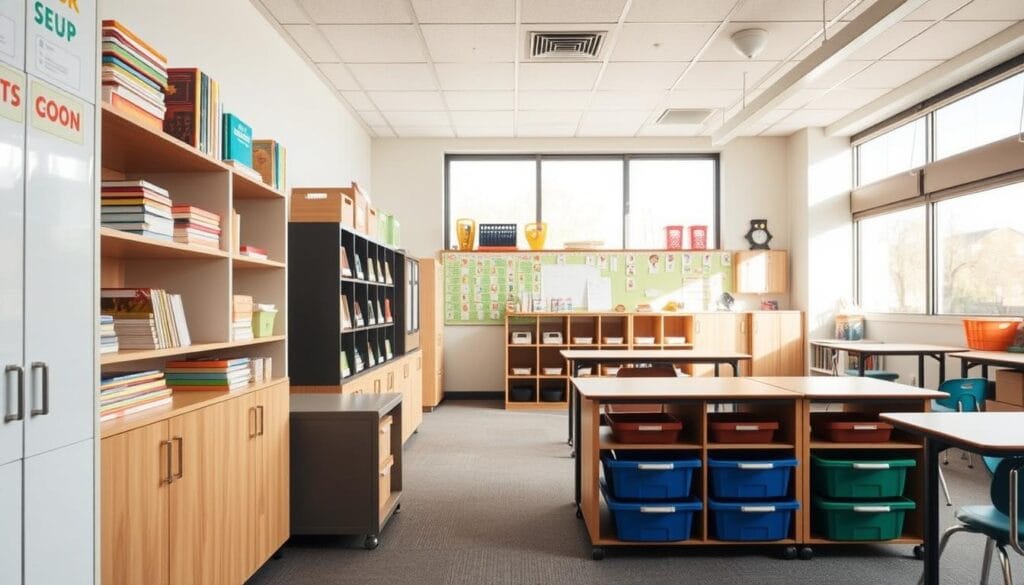
Effective classroom storage is key to a successful learning space. With 83% of teachers saying organization helps students learn, smart storage is vital. It makes classrooms run smoothly.
Transform your classroom with smart material management. Using color-coded systems and labeled storage can cut down on searching time by up to 30%. This makes daily tasks easier and more efficient.
Key Storage Strategies
- Utilize vertical storage solutions to maximize limited space
- Implement color-coded labeling systems
- Create designated areas for different materials
- Use multi-functional furniture with built-in storage
Try these innovative storage ideas:
| Storage Type | Benefits | Efficiency Increase |
|---|---|---|
| Rolling Carts | Mobile supply management | 30% accessibility improvement |
| Wall-Mounted Shelves | Maximize vertical space | 40% space optimization |
| Transparent Bins | Easy material identification | 25% quicker access |
Teaching students to keep things organized is just as important. By giving them classroom jobs and clear systems, you can boost their sense of responsibility by 60%. Remember, a well-organized classroom is a more effective learning space.
By using these strategies, you can create a learning environment that supports students. It will be clutter-free and empower students to care for their space.
Implementing Effective Classroom Routines
Setting up consistent classroom procedures is key to good classroom management. Your daily routine shapes learning, student engagement, and classroom productivity. By setting up smart routines, you can make a structured space. This space cuts down on distractions and boosts learning time.
Creating effective classroom procedures needs careful planning and regular use. Studies show 78% of teachers think setting clear rules early is vital for classroom success.
Morning Setup Procedures
Begin your day with a structured morning routine. This helps students get ready for learning. Here are some strategies to consider:
- Create a clear entry protocol
- Display a morning task checklist
- Use interactive modeling to show what’s expected
- Do quick morning check-in activities
Transition Time Management
Smooth transitions keep the classroom running smoothly. Try these methods:
- Use countdown timers for station changes
- Hand signals for quiet communication
- Have set transition steps
- Use visual cues and anchor charts
End-of-Day Organization
Ending the day with purpose helps students learn classroom management. Create a daily end routine that includes:
- Quick classroom clean-up
- Reflection time
- Getting ready for tomorrow
- Assigning student tasks
By following these steps, you can make a well-organized learning space. This space supports student success and lowers behavioral issues.
Technology Integration and Digital Organization
Digital tools have changed how we organize and manage classrooms. Ninety percent of teachers think tech helps students a lot. So, using technology is key for today’s teaching methods.
Smart digital solutions can make your classroom management better. Here are some important tech approaches:
- Use cloud-based platforms for lesson planning
- Implement digital attendance tracking systems
- Create online grade management repositories
- Develop digital communication channels with parents
Classroom organization now goes beyond just physical spaces. 77% of teachers use technology daily for communication. This shows how important digital tools are in schools.
Using technology well means more than just getting devices. You need to set rules for how to use them. With 85% of schools letting students use their devices, having good digital systems is crucial.
Here are some key tech management strategies:
- Implementing device tracking systems
- Creating designated charging stations
- Developing clear digital usage guidelines
- Training students in digital responsibility
By using tech, you make your classroom a place of learning that’s ready for the digital world.
Conclusion
Classroom organization is more than just setting up furniture and supplies. Studies show that a well-organized classroom can boost student engagement by up to 30%. A good classroom setup helps students learn better, stay focused, and succeed in school.
When organizing your classroom, remember to stay flexible. Every classroom is different, and what works for one group might not work for another. Listen to your students and adjust your plans as needed. Involving students in classroom management can make them more likely to follow rules, by about 30%.
Teaching is a continuous journey, and so is classroom organization. A well-organized classroom sets the stage for success, motivation, and positive learning experiences. Your dedication to a well-planned classroom can greatly improve student performance and create a supportive learning environment.
Begin with small steps, stay consistent, and watch your classroom transform. It will become a vibrant, engaging place where students can excel both academically and personally.


